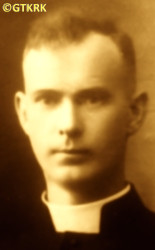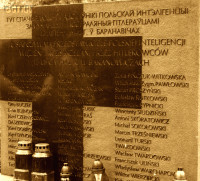Roman Catholic
St Sigismund parish
05-507 Słomczyn
85 Wiślana Str.
Konstancin deanery
Warsaw archdiocese, Poland
full list:
displayClick to display full list

searchClick to search full list by categories
wyświetlKliknij by wyświetlić pełną listę po polsku

szukajKliknij by przeszukać listę wg kategorii po polsku

Martyrology of the clergy — Poland
XX century (1914 – 1989)
personal data
surname
SIUDZIŃSKI
surname
versions/aliases
STUDZIŃSKI (błędnie)
forename(s)
Vincent (pl. Wincenty)
function
diocesan priest
creed
Latin (Roman Catholic) Church RCmore on
en.wikipedia.org
[access: 2014.09.21]
congregation
Congregation of Missionary Oblates of Mary Immaculate OMImore on
en.wikipedia.org
[access: 2013.05.19]
(i.e. Oblates)
diocese / province
Pinsk diocesemore on
en.wikipedia.org
[access: 2013.05.19]
Polish province OMI
honorary titles
„Medal of Independence”more on
„Medal of Independence”
(19.12.1933)
„Cross of Valour”more on
„Cross of Valour”
Commemorative Medal for War of 1918–21more on
Commemorative Medal for War of 1918-21
„For Insurgent in Arms Greatful Greater Poland” badgemore on
„For Insurgent in Arms Greatful Greater Poland” badge
date and place
of death
13.07.1942

Polonkatoday: Polonka ssov., Baranavichy dist., Brest reg., Belarus
more on
be.wikipedia.org
[access: 2023.01.18]
details of death
Participant of Greater Poland Uprising 1918‐1919. Member of Polish partisan unit from home Młyny. Took part in battles of Strzelno and Inowrocław.
Next soldier of Kuyavian Grenadiers Regiment (on 07.02.1919 rebranded as 5th Greater Poland Riflemen Regiment, and on 17.01.1920 as 59th Greater Poland Infantry Regiment). Prob. took part in battling through Pomerania and taking it over from the Germans (starting on 17.01.1920).
Next, as a unit of 15th Infantry Division and later of 13th Infantry Division of the Polish Army, sent to Ukrainian front. Took part in battles of river Słucz (among others n. Kowaleńki). Soon after that participated in Kiev Offensive and on 08.05.1920 entered Kiev itself. From there moved on 30.05.1920 to Minsk in Belarus.
During Russian invasion of Poland defended in 08.1920 n. Wiązowna n. Warsaw. On 17.08.1920 broke through the Russian front and on 22.08.1920 took part in victorious capture of Łomża. The Polish–Russian war of 1919‐1921 campaign finished in Raków on Belarus.
After German and Russian invasion of Poland in 09.1939 and start of the World War II, after start of Russian occupation prob. evicted from the rectory and after closure of the church by the Russians ministered in private houses.
After German attack on 22.06.1941 of their erstwhile ally, Russians, and start of German occupation, after murder of his parish priest, Fr Lucian Strumiłło–Pietraszkiewicz, on 29.06.1941, took over Swojatycze parish.
Arrested by the Germans and collaborating with them Belarusians prob. on c. 26.06.1942.
Taken to Baranavichy prison.
Next on c. 03.07.1942 transported to KL Koldichevo concentration camp.
From there driven out on a truck to the execution site.
cause of death
mass murder
perpetrators
Germans / Belarusians
sites and events
Połonka (n. Baranavichy)Click to display the description, «Polenaktion» 1942Click to display the description, KL KoldichevoClick to display the description, Baranavichy (prison)Click to display the description, Ribbentrop‐MolotovClick to display the description, Pius XI's encyclicalsClick to display the description, Polish‐Russian war of 1919‐1921Click to display the description, Polish‐Ukrainian war of 1918‐1919Click to display the description, Greater Poland UprisingClick to display the description
date and place
of birth
10.01.1899Birth certification on:
www.genealogiawarchiwach.pl
[access: 2025.09.08]

Młynytoday: Strzelno gm., Mogilno pov., Kuyavia‐Pomerania voiv., Poland
more on
en.wikipedia.org
[access: 2021.12.18]
parents
SIUDZIŃSKI Vincent
🞲 1857, ? — 🕆 ?, ?

ŁÓJ Josefa
🞲 1860, ? — 🕆 ?, ?
presbyter (holy orders)
ordination
04.1933

positions held
1941 – 1942
administrator — Svajatyčytoday: Zherebkovichi ssov., Lyakhavichy dist., Brest reg., Belarus
more on
be.wikipedia.org
[access: 2023.01.18] ⋄ St George RC parish ⋄ Stalavichytoday: Stalavichy ssov., Baranavichy dist., Brest reg., Belarus
more on
be.wikipedia.org
[access: 2022.12.25] RC deanery
till 1941
vicar — Svajatyčytoday: Zherebkovichi ssov., Lyakhavichy dist., Brest reg., Belarus
more on
be.wikipedia.org
[access: 2023.01.18] ⋄ St George RC parish ⋄ Stalavichytoday: Stalavichy ssov., Baranavichy dist., Brest reg., Belarus
more on
be.wikipedia.org
[access: 2022.12.25] RC deanery
1938 – 1939
prefect — Baranavichytoday: Baranavichy dist., Brest reg., Belarus
more on
en.wikipedia.org
[access: 2022.05.02] ⋄ Exaltation of the Holy Cross RC parish ⋄ Baranavichytoday: Baranavichy dist., Brest reg., Belarus
more on
en.wikipedia.org
[access: 2022.05.02] RC deanery — private secondary schools
1935 – c. 1938
administrator — Lakhvatoday: Lakhva ssov., Luninets dist., Brest reg., Belarus
more on
en.wikipedia.org
[access: 2020.12.11] ⋄ RC parish ⋄ Luninetstoday: Luninets dist., Brest reg., Belarus
more on
en.wikipedia.org
[access: 2021.09.02] RC deanery — also: rector of the filial church in Brodnytska Wolya (c. 1936)
c. 1934 – 1935
vicar — Mikashevichytoday: Luninets dist., Brest reg., Belarus
more on
en.wikipedia.org
[access: 2020.12.11] ⋄ Assumption of the Blessed Virgin Mary RC parish ⋄ Luninetstoday: Luninets dist., Brest reg., Belarus
more on
en.wikipedia.org
[access: 2021.09.02] RC deanery — also: minister of the church in the village of Lenin
1933 – c. 1934
prefect — Pinsktoday: Pinsk city dist., Brest reg., Belarus
more on
en.wikipedia.org
[access: 2022.07.16] ⋄ secondary schools ⋄ Assumption of the Blessed Virgin Mary RC cathedral parish ⋄ Pinsktoday: Pinsk city dist., Brest reg., Belarus
more on
en.wikipedia.org
[access: 2022.07.16] RC deanery
c. 1930 – 1933
student — Pinsktoday: Pinsk city dist., Brest reg., Belarus
more on
en.wikipedia.org
[access: 2022.07.16] ⋄ philosophy and theology, St Thomas Aquinas' Theological Seminary
1929
leaving — Oblates OMI
from 14.08.1927/09.11.1927
novitiate — Markowicetoday: Strzelno gm., Mogilno pov., Kuyavia‐Pomerania voiv., Poland
more on
en.wikipedia.org
[access: 2021.06.07] ⋄ Immaculate Conception of the Blessed Virgin Mary Congregation's house, Oblates OMI
1927
accession — Oblates OMI
others related
in death
STRUMIŁŁO–PIETRASZKIEWICZClick to display biography Lucian, BARTUSZEKClick to display biography Joseph, BRYCZKOWSKIClick to display biography Boleslav, BUJNOWSKIClick to display biography Leo, GRZESIAKClick to display biography Thaddeus Michael, KARAMUCKIClick to display biography Louis, KLIMCZAKClick to display biography Vladislav, KUBIKClick to display biography Mieczyslav Anthony, KURAŚClick to display biography Vincent, MĄCIORClick to display biography Thomas, OLESZCZUKClick to display biography Alphonse, PAWŁOWSKIClick to display biography Vladislav Sigismund, RUTKOWSKIClick to display biography Boleslav, ULIŃSKIClick to display biography Francis, WARCHAPOWICZClick to display biography Vladislav, WIERZBICKIClick to display biography Victor
sites and events
descriptions
Połonka (n. Baranavichy): Mass a group of approx. 50‐400 people (mainly Poles, including c. 15‐17 priests) carried out on 13.07.1942 2 by the Germ. Sonderkommando — a special unit of the Germ. Weißruthenische Hilfspolizei (Eng. Belarusian Auxiliary Police) collaborating with the Germans. The execution took place in a forest by Połonka village, c. 25 km to west from Baranavichy, and the wire‐bound prisoners where brought from KL Koldichevo concentration camp and Baranavichy prison. Prob. was part of German special action aimed at Polish intelligentsia and including mass herding and sending to Germany of Polish slave workers, known as «Polenaktion». (more on: www.stankiewicze.comClick to attempt to display webpage
[access: 2013.02.15], genealogia.plewako.plClick to attempt to display webpage
[access: 2014.09.21])
«Polenaktion» 1942: In the summer of 1942 in German‐occupied Germ. Generalbezirk Weißruthenien (Eng. General Region of Belarus) — in Nowogródek region among others — Germans carried out «Polenaktion» initiative: the name introduced in a special resolution drafted by Reichssicherheitshauptamt RSHA (Eng. Reich Main Security Office). The action included sacking of all Poles from civilian regional apparatus and police and replacing them with Belarusians. Thousands of Poles were also forcibly deported to Germany as slave labourers. On 26‐30.06.1942 in all counties of the region more than 1,000 representatives of Polish intelligentsia were arrested and subsequently murdered. In Lida region 16 Polish priests were arrested among others. 5 Polish parish priests from Hlybokaye and Pastavy deanery were murdered as well. At the same time Germans set up KL Koldichevo concentration camp n. Baranavichy. The implementation of this genocide project was entrusted to Belarusian collaborationist formations, political, administrative — responsible for preparation of proscription lists — and police, i.e. niem. Weißruthenische Hilfspolizei (Eng. Belarusian Auxiliary Police), supported by Ukrainian, Lithuanian, Latvian and Russian (RONA) collaborators. The action was coordinated with the liquidation of the Jewish ghettos in the Germ. Generalbezirk Weißruthenien.
KL Koldichevo: German Germ. Konzentrationslager (Eng. concentration camp) KL and death/extermination camp operational from 03.1942 to 07.1944 in Koldychevo village, 20 km from Baranavichy, in Belarus — to be precise in Germ. Generalbezirk Weißruthenien (Eng. General Districtorate of Belarus), part of the occupation entity called the Germ. Reichskommissariat Ostland (Eng. Reichskommissariat East). Jews and Poles, among others, were held in the camp, which was supervised by several Germans, but the managers, guards and executioners were Belarusians, and the language of orders and commands was Belarusian — the crew were members of the 4th Company of the 13th Belarusian Police Battalion SD (Germ. Weissruthenische Schutzmannschafts Bataillon der SD 13), which was part of the collaborationist Germ. Weißruthenische Hilfspolizei (Eng. Belarusian Auxiliary Police). A crematorium was opened in the camp. It witnessed c. 22,000 victims being murdered and exterminated — men, women, children, old, of various professions and social status, mainly Polish nationals, including c. 24 Catholic priests. Some of them were murdered by deadly gas, prob. in specially equipped trucks (the bodies were subsequently dumped in Lakhivka forest, c. 2 km from the camp). Others were taken to Polonka and murdered there. Victims were also murdered by the Belarusians with a shot to the back of the head or with sticks with protruding nails. (more on: en.wikipedia.orgClick to attempt to display webpage
[access: 2023.08.31], www.sztetl.org.plClick to attempt to display webpage
[access: 2013.12.04])
Baranavichy (prison): Prison in 1939‐1941 run by Russians and in 1941‐1944 by Germans. (more on: pl.wikipedia.orgClick to attempt to display webpage
[access: 2013.08.17])
Ribbentrop‐Molotov: Genocidal Russian‐German alliance pact between Russian leader Joseph Stalin and German leader Adolf Hitler signed on 23.08.1939 in Moscow by respective foreign ministers, Mr. Vyacheslav Molotov for Russia and Joachim von Ribbentrop for Germany. The pact sanctioned and was the direct cause of joint Russian and German invasion of Poland and the outbreak of the World War II in 09.1939. In a political sense, the pact was an attempt to restore the status quo ante before 1914, with one exception, namely the „commercial” exchange of the so‐called „Kingdom of Poland”, which in 1914 was part of the Russian Empire, fore Eastern Galicia (today's western Ukraine), in 1914 belonging to the Austro‐Hungarian Empire. Galicia, including Lviv, was to be taken over by the Russians, the „Kingdom of Poland” — under the name of the General Governorate — Germany. The resultant „war was one of the greatest calamities and dramas of humanity in history, for two atheistic and anti‐Christian ideologies — national and international socialism — rejected God and His fifth Decalogue commandment: Thou shall not kill!” (Abp Stanislav Gądecki, 01.09.2019). The decisions taken — backed up by the betrayal of the formal allies of Poland, France and Germany, which on 12.09.1939, at a joint conference in Abbeville, decided not to provide aid to attacked Poland and not to take military action against Germany (a clear breach of treaty obligations with Poland) — were on 28.09.1939 slightly altered and made more precise when a treaty on „German‐Russian boundaries and friendship” was agreed by the same murderous signatories. One of its findings was establishment of spheres of influence in Central and Eastern Europe and in consequence IV partition of Poland. In one of its secret annexes agreed, that: „the Signatories will not tolerate on its respective territories any Polish propaganda that affects the territory of the other Side. On their respective territories they will suppress all such propaganda and inform each other of the measures taken to accomplish it”. The agreements resulted in a series of meeting between two genocidal organization representing both sides — German Gestapo and Russian NKVD when coordination of efforts to exterminate Polish intelligentsia and Polish leading classes (in Germany called «Intelligenzaktion», in Russia took the form of Katyń massacres) where discussed. Resulted in deaths of hundreds of thousands of Polish intelligentsia, including thousands of priests presented here, and tens of millions of ordinary people,. The results of this Russian‐German pact lasted till 1989 and are still in evidence even today. (more on: en.wikipedia.orgClick to attempt to display webpage
[access: 2015.09.30])
Pius XI's encyclicals: Facing the creation of two totalitarian systems in Europe, which seemed to compete with each other, though there were more similarities than contradictions between them, Pope Pius XI issued in 03.1937 (within 5 days) two encyclicals. In the „Mit brennender Sorge” (Eng. „With Burning Concern”) published on 14.03.1938, condemned the national socialism prevailing in Germany. The Pope wrote: „Whoever, following the old Germanic‐pre‐Christian beliefs, puts various impersonal fate in the place of a personal God, denies the wisdom of God and Providence […], whoever exalts earthly values: race or nation, or state, or state system, representatives of state power or other fundamental values of human society, […] and makes them the highest standard of all values, including religious ones, and idolizes them, this one […] is far from true faith in God and from a worldview corresponding to such faith”. On 19.03.1937, published „Divini Redemptoris” (Eng. „Divine Redeemer”), in which criticized Russian communism, dialectical materialism and the class struggle theory. The Pope wrote: „Communism deprives man of freedom, and therefore the spiritual basis of all life norms. It deprives the human person of all his dignity and any moral support with which he could resist the onslaught of blind passions […] This is the new gospel that Bolshevik and godless communism preaches as a message of salvation and redemption of humanity”… Pius XI demanded that the established human law be subjected to the natural law of God , recommended the implementation of the ideal of a Christian state and society, and called on Catholics to resist. Two years later, National Socialist Germany and Communist Russia came together and started World War II. (more on: www.vatican.vaClick to attempt to display webpage
[access: 2023.05.28], www.vatican.vaClick to attempt to display webpage
[access: 2023.05.28])
Polish‐Russian war of 1919‐1921: War for independence of Poland and its borders. Poland regained independence in 1918 but had to fight for its borders with former imperial powers, in particular Russia. Russia planned to incite Bolshevik‐like revolutions in the Western Europe and thus invaded Poland. Russian invaders were defeated in 08.1920 in a battle called Warsaw battle („Vistula river miracle”, one of the 10 most important battles in history, according to some historians). Thanks to this victory Poland recaptured part of the lands lost during partitions of Poland in XVIII century, and Europe was saved from the genocidal Communism. (more on: en.wikipedia.orgClick to attempt to display webpage
[access: 2014.12.20])
Polish‐Ukrainian war of 1918‐1919: One of the wars for borders of the newly reborn Poland. At the end of 1918 on the former Austro‐Hungarian empire’s territory, based on the Ukrainian military units of the former Austro‐Hungarian army, Ukrainians waged war against Poland. In particular attempted to create foundation of an independent state and attacked Lviv. Thanks to heroic stance of Lviv inhabitants, in particular young generation of Poles — called since then Lviv eaglets — the city was recaptured by Poles and for a number of months successfully defended against furious Ukrainian attacks. In 1919 Poland — its newly created army — pushed Ukrainian forces far to the east and south, regaining control over its territory. (more on: en.wikipedia.orgClick to attempt to display webpage
[access: 2017.05.20])
Greater Poland Uprising: Military insurrection of Poles of former German Germ. Posen Provinz (Eng. Poznań province) launched against German Reich in 1918‐1919 — after the abdication on 09.11.1918 of the German Emperor William II Hohenzollern; after the armistice between the Allies and Germany signed on 11.1.1918 in the HQ wagon in Compiègne, the headquarters of Marshal of France Ferdinand Foch — which de facto meant the end of World War I — against the German Weimar Republic, established on the ruins of the German Empire, aiming to incorporate lands captured by Prussia during partitions of Poland in XVIII century into Poland. The Republic of Poland, reborn on 11.11.1918, initially formally included only the so‐called Germ. Königreich Polen (Eng. Kingdom of Poland), i.e. the territory that had been under Russian rule until 1915 and then under the control of Central States (Germany and Austria–Hungary), but did not include the Prussian partition. Started on 27.12.1918 in Poznań and ended on 16.02.1919 with the armistice pact in Trier, forced by the victorious Entente states, which included provisions ordering Germany to cease operations against Poland and, importantly, recognizing the Polish insurgent Greater Poland Army as an allied armed force of the Entente. De facto it turned out to be a Polish victory, confirmed in the main peace treaty after World War I, the Treaty of Versailles of 28.06.1919, which came into force on 10.01.1920 and in which most of the lands of the Prussian partition were recognized as Polish. Many Polish priests took part in the Uprising, both as chaplains of the insurgents units and members and leaders of the Polish agencies and councils set up in the areas covered by the Uprising. In 1939 after German invasion of Poland and start of the World War II those priests were particularly persecuted by the Germans and majority of them were murdered. (more on: en.wikipedia.orgClick to attempt to display webpage
[access: 2016.08.14])
sources
personal:
wastan.plClick to attempt to display webpage
[access: 2012.12.28], www.stankiewicze.comClick to attempt to display webpage
[access: 2013.02.15], www.genealogiawarchiwach.plClick to attempt to display webpage
[access: 2025.09.08], strzelnomojemiasto.blogspot.comClick to attempt to display webpage
[access: 2019.10.13]
bibliographical:
„Martyrology of the Polish Roman Catholic clergy under nazi occupation in 1939‐1945”, Victor Jacewicz, John Woś, vol. I‐V, Warsaw Theological Academy, 1977‐1981
„Pinsk Diocese in Poland Clergy and Church Register”, Pinsk diocese bishop, 1933‐1939, diocesan printing house
original images:
strzelnomojemiasto.blogspot.comClick to attempt to display webpage
[access: 2019.10.13], strzelnomojemiasto.blogspot.comClick to attempt to display webpage
[access: 2019.10.13], www.svaboda.orgClick to attempt to display webpage
[access: 2015.09.30]
LETTER to CUSTODIAN/ADMINISTRATOR
If you have an Email client on your communicator/computer — such as Mozilla Thunderbird, Windows Mail or Microsoft Outlook, described at WikipediaPatrz:
en.wikipedia.org, among others — try the link below, please:
LETTER to CUSTODIAN/ADMINISTRATORClick and try to call your own Email client
If however you do not run such a client or the above link is not active please send an email to the Custodian/Administrator using your account — in your customary email/correspondence engine — at the following address:

giving the following as the subject:
MARTYROLOGY: SIUDZIŃSKI Vincent
To return to the biography press below:
 Click to return to biography
Click to return to biography












